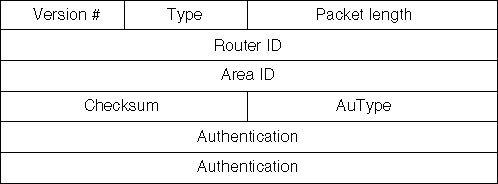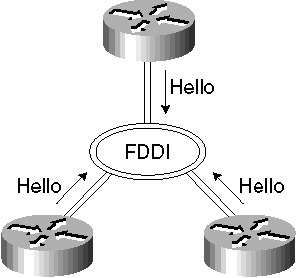| Previous | Table of Contents | Next |
OSPF will designate a single router per multiaccess network to build adjacencies among all other routers. A DR is elected by OSPF’s Hello protocol (which is discussed later). The presence of a DR will reduce the number of adjacencies that are formed, which in turn reduces the amount of routing protocol traffic, router overhead, and the size of the OSPF link-state database. Designated Routers are very beneficial, but how does OSPF figure out which router on a network will be the DR? The following sequence describes how OSPF determines which router will be the DR:
Notes:
The steps described on how a DR is elected assumes that none exists on that network. If this is not the case, the process alters slightly and you should refer to the RFC 2328 for additional information.
- 1. OSPF selects a router at random and examines its list of neighbors; call this Router T. This list of router neighbors consists of all the routers that have begun bi-directional communication among themselves. This communication is referred to as “2-way” and is the most advanced state of communication neighboring routers can achieve without actually forming an adjacency.
- 2. Router T removes from that list all routers that are ineligible to become the DR. This would consist of routers that have an OSPF-assigned routing priority of 0. Proceed to the next step with the remaining routers on the list.
- 3. The backup DR is actually chosen first and is determined through calculations on which router has the highest priority. If more than one router has the same priority value, in essence they have become tied. Priority values can be defined or allowed to default. OSPF will take the router with the highest router ID in order to break the tie. If there is already a DR in existence, then any router is ineligible for election at this point.
- 4. If no other router has declared itself to be the DR, then assign the newly commissioned backup DR to become the DR.
- 5. If Router T is now the new DR, then repeat Steps 3 and 4 to get a backup DR assigned and proceed to Step 6. For example, if Router T is the DR, it will not be eligible for election when Step 3 is repeated. This ensures that no router will declare itself both the DR and backup DR.
- 6. As a result of these calculations, Router T has become the DR and the router’s OSPF interface state is set accordingly. For example, the DR has a new interface state of DR and the backup DR has an interface state of DR Other.
- 7. The DR will now begin sending hello packets to begin the process of building the necessary adjacencies with the remainder of the network’s routers.
Protocols Within OSPF OSPF routers communicate with each by using the OSPF protocol. OSPF runs on top of IP, though OSPF is composed of three subprotocols: Hello, Exchange, and Flooding. The following sections discuss these three subprotocols in greater detail. All OSPF packets start with a common header. Figure 4-4 illustrates a breakdown (by field) of the common header found at the beginning of each packet issued by an OSPF subprotocol. 
Figure 4-4 Common OSPF subprotocol header.
The Hello Protocol The OSPF Hello protocol is used for three main purposes: - • To verify that links are operational
- • To elect the DR and backup DR on broadcast and non-broadcast networks
- • To discover, establish, and maintain neighbor relationships
In addition, the Hello protocol is responsible for ensuring that communication between OSPF neighbors is bi-directional (two-way). This type of communication is established when the router sees itself listed in its neighbor’s hello packet. Figure 4-5 demonstrates how OSPF routers issue hello packets into the network in order to discover their neighbors. 
Figure 4-5 Hello protocol operation.
The basic operation of the Hello protocol can be briefly listed as follows: - 1. OSPF router sends out hello packet as a broadcast.
- 2. The hello packet is received by the new OSPF router.
- 3. New router replies back with its own hello packet.
Hello Protocol Operation Variation in OSPF Network Types The Hello protocol works differently on the point-to-point, multiaccess, and NBMA OSPF network types. In broadcast networks, each router will advertise itself by periodically sending out multicasted hello packets, which allows neighbors to be discovered dynamically. In NBMA networks, the OSPF router might require some configuration information in order for the Hello protocol to operate correctly. This configuration is actually the protocol going out onto the network to find or elect the designated router, as previously discussed in the section, “OSPF Network Types.”
TIPS:
Unless otherwise configured, Hello packets will default to a transmission time of once every 10 seconds or 30 seconds for NBMA. Alternatively, this can be set with the command: ip ospf hello-interval, which will be discussed in Chapter 6, “Advanced OSPF Design Concepts.”
In point-to-point or point-to-multipoint networks, the OSPF router will send out hello packets to every neighbor with which it can communicate directly.
TIPS:
In point-to-point networks, an OSPF hello packet is sent as a multicast packet. In point-to-multipoint networks, it could be sent as multicast if the data link layer replicated the packet. Or neighbor information could be configured to indicate who to send the hello to if the data link replication does not work, such as the ATM ARP server model.
| Previous | Table of Contents | Next |
| 
